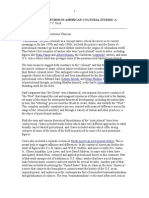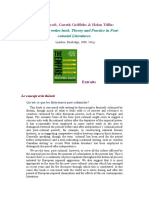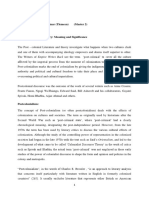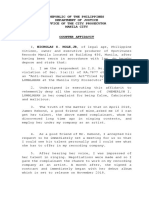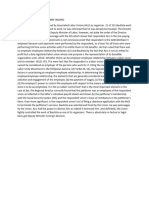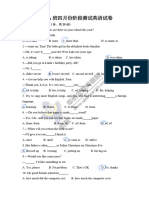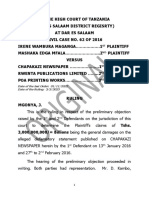Post Colonial History
Uploaded by
S LalruatfelaPost Colonial History
Uploaded by
S LalruatfelaPOSTCOLONIALISM
Postcolonialism (or post-colonialism—either spelling is acceptable, but each
represents slightly different theoretical assumptions) consists of a set of theories
in philosophy and various approaches to literary analysis that are concerned
with literature written in English in countries that were or still are colonies of
other countries. For the most part, postcolonial studies excludes literature that
represents either British or American viewpoints and concentrates on writings
from colonized or formerly colonized cultures in Australia, New Zealand,
Africa, South America, and other places that were once dominated by, but
remained outside of, the white, male, European cultural, political, and
philosophical tradition. Referred to as “third-world literature” by Marxist critics
and “Commonwealth literature” by others—terms many contemporary critics
think pejorative—postcolonial theorists investigate what happens when two
cultures clash and one of them, with its accessory ideology, empowers and
deems itself superior to the other.
Historical Development
Rooted in colonial power and prejudice, postcolonialism develops from a four-
thousand-year history of strained cultural relations between colonies in Africa
and Asia and the Western world. Throughout this long history, the West became
the colonizers, and many African and Asian countries and their peoples became
the colonized. During the nineteenth century, Great Britain emerged as the
largest colonizer and imperial power, quickly gaining control of almost one
quarter of the earth’s landmass. By the middle of the nineteenth century, terms
such as colonial interests and the British Empire were widely used both in the
media and in government policies and international politics. Many British
people believed that Great Britain was destined to rule the world. Likewise, the
assumption that Western Europeans and, in particular, the British people were
biologically superior to any other race—a term for a class of people based on
physical and/or cultural distinctions— remained relatively unquestioned.
Such beliefs directly affected the ways in which the colonizers treated the
colonized. Using its political and economic strength, Great Britain, the chief
imperialist power of the nineteenth century, dominated her colonies, making
them produce then give up their countries’ raw materials in exchange for what
material goods the colonized desired or were made to believe they desired by
the colonizers. Forced labor of the colonized became the rule of the day, and
thus the institution of slavery was commercialized. Often the colonizers
justified their cruel treatment of the colonized by invoking European religious
beliefs. From the perspective of many white Westerners, the peoples of Africa,
the Americas, and Asia were “heathens,” possessing pagan ways that must be
Christianized. How one treats peoples who are so defined does not really matter,
they maintained, because many Westerners subscribed to the colonialist
ideology that all races other than white were inferior or subhuman. These
subhumans or “savages” quickly became the inferior and equally “evil” Others,
a philosophical concept called alterity whereby “the Others” are excluded from
positions of power and viewed as both different and inferior.
By the early twentieth century, England’s political, social, economic, and
ideological domination of its colonies began to disappear, a process known as
decolonization. By mid century, for example, India had gained her
independence from British colonial rule. Many scholars believe that this event
marks the beginning of postcolonialism or third-world studies, a term coined
by the French demographer Alfred Sauvy. When India received her
independence, the former British colony was divided into two nations, the India
Union and Pakistan. This partitioning, what scholars dub the “Great Divide,”
led to ethnic conflict of enormous proportions between India, a new member of
the British Commonwealth in 1947, and the mostly Muslim state of Pakistan.
Hundreds of thousands of people died in the struggle, igniting the outrage of a
vast array of scholars, writers, and critics concerning the social, moral, political,
and economic conditions of the after effects of colonialism in what were once
called third-world countries.
The beginnings of postcolonialism’s theoretical and social concerns can be
traced to the 1950s. Along with India’s independence, this decade witnessed the
ending of France’s long involvement in Indochina; the parting of the ways
between the two leading figures in existential theory, Jean-Paul Sartre and
Albert Camus, over their differing views about Algeria; Fidel Castro’s now-
famous “History Shall Absolve Me” speech; and the publication of Frantz
Fanon’s Black Skin, White Masks (1952) and Chinua Achebe’s novel Things
Fall Apart (1958).
The following decades witnessed the publication of additional key texts that
articulated the social, political, and economic conditions of various subaltern
groups. In 1960 the Caribbean writer George Lamming published The Pleasures
of Exile, a text in which Lamming critiques William Shakespeare’s play The
Tempest from a postcolonial perspective. The next year Fanon published The
Wretched of the Earth (1961), a work that highlights the tensions or binary
oppositions of white versus black, good versus evil, and rich versus poor, to cite
a few. Other writers, philosophers, and critics such as Albert Memmi continued
publishing texts such as The Colonizer and the Colonized (1965, English
version) that would soon become the cornerstone of postcolonial theory and
writings. In particular, postcolonialism gained the attention of the West with the
publication of Edward Said’s Orientalism (1978) and Bill Ashcroft, Gareth
Griffiths, and Helen Tiffin’s monumental text The Empire Writes Back: Theory
and Practice in Post-Colonial Literatures (1989). With the publication of these
two texts, the voices and the concerns of many subaltern cultures would soon be
heard in both academic and social arenas.
The terms postcolonial and postcolonialism first appear in scholarly journals in
the mid-1980s and as subtitles in texts such as Ashcroft, Griffiths, and Tiffin’s
previously mentioned powerful work and in 1990 in Ian Adam and Helen
Tiffin’s Past the Last Post: Theorizing Post-Colonialism and PostModernism.
By the early and mid-1990s, both terms had become firmly established in
academic and popular discourse.
Similar to deconstruction and other postmodern approaches to textual analysis,
postcolonialism refers to a heterogeneous field of study in which even its
spelling provides several alternatives: post-colonialism, postcolonialism, or
post/colonial. When spelled with a hyphen (post-colonialism), the term implies
a chronological order—that is, a change from a colonial to a postcolonial state.
When spelled without the hyphen (postcolonialism), the term refers “to writing
that sets out in one way or another to resist colonialist perspectives,” both
before and after the period of colonization. According to some critics, the
nonhyphenated spelling covers a wider critical field, including literature of
former British colonies, than does the hyphenated spelling. The third
orthographic variant of this term (post/colonial), argue some critics, is more
relevant than the previous two spellings because it stresses the interrelatedness
between an indeterminate number of literatures—be they Anglophone or not—
that share a similar situation: the “entangled condition” that exists between
colonial and post/colonial discourse and between coloniality and
post/coloniality. Today the most common spelling of the three variants is
postcolonialism.
Many of postcolonialism’s adherents suggest there are two branches. The first
views postcolonialism as a set of diverse methodologies that possess no unitary
quality, as argued by Homi K. Bhabha and Arun P. Murkherjee. The second
branch includes those critics such as Edward Said, Barbara Harlow, and Gayatri
Chakravorty Spivak who view postcolonialism as a set of cultural strategies
“centered in history.” This latter group can also be subdivided into those who
believe postcolonialism refers to that period after the colonized countries have
gained their independence as opposed to those who regard postcolonialism as
referring to all the characteristics of a society or culture from the time of
colonization to the present moment.
Postcolonialism’s concerns become evident when we examine the various
topics discussed in one of its most prominent texts, The Post-Colonial Studies
Reader (1995), edited by Ashcroft, Griffiths, and Tiffin. Its subjects include
universality, difference, nationalism, postmodernism, representation and
resistance, ethnicity, feminism, language, education, history, place, and
production. As diverse as these topics are, they draw attention to
postcolonialism’s major concern: the struggle that occurs when one culture is
dominated by another. As postcolonial critics point out, to be colonized is “to be
removed from history.” In its interaction with the conquering culture, the
colonized or indigenous culture is forced to go underground or to be obliterated.
Only after colonization occurs and the colonized people have had time to think
and to write about their oppression and loss of cultural identity does
postcolonial theory come into existence. Postcolonial theory is born out of the
colonized peoples’ frustrations, their direct and personal cultural clashes with
the conquering culture, and their fears, hopes, and dreams about the future and
their own identities. How the colonized respond to changes in language,
curricular matters in education, race differences, economic issues, morals,
ethics, and a host of other concerns, including the act of writing itself, becomes
the context for the evolving theories and practice of postcolonialism.
You might also like
- 3 Postcolonialtheory-Meaning and Significane PDFNo ratings yet3 Postcolonialtheory-Meaning and Significane PDF82 pages
- Ahmad Aijaz in Theory Classes Nations Literatures PDFNo ratings yetAhmad Aijaz in Theory Classes Nations Literatures PDF8 pages
- Postcolonial Criticism "Ethnic Studies"No ratings yetPostcolonial Criticism "Ethnic Studies"13 pages
- S6 POSTCOLONIAL LITERATURE CONTENT 2023-24No ratings yetS6 POSTCOLONIAL LITERATURE CONTENT 2023-2425 pages
- What is Postcolonial Literature - Ato Quayson 2020No ratings yetWhat is Postcolonial Literature - Ato Quayson 20202 pages
- Postcolonial Imagination and Postcolonial TheoryNo ratings yetPostcolonial Imagination and Postcolonial Theory11 pages
- Postcolonial Aspects in Canadian FictionNo ratings yetPostcolonial Aspects in Canadian Fiction59 pages
- X. Postcolonial & Transnational TheoriesNo ratings yetX. Postcolonial & Transnational Theories22 pages
- Postcolonial Writings: University of CalicutNo ratings yetPostcolonial Writings: University of Calicut150 pages
- Postcolonialism... Involves A Studied Engagement With The Experience of Colonialism and Its Past and Present EffectsNo ratings yetPostcolonialism... Involves A Studied Engagement With The Experience of Colonialism and Its Past and Present Effects3 pages
- The Empire Writes Back. Theory and Practice in Post-Colonial LiteraturesNo ratings yetThe Empire Writes Back. Theory and Practice in Post-Colonial Literatures8 pages
- Hybridity and National Identity in Postcolonial Literature Annotated BibliographyNo ratings yetHybridity and National Identity in Postcolonial Literature Annotated Bibliography6 pages
- Postcolonial Theory and African Literature: by Babatunde E. ADIGUNNo ratings yetPostcolonial Theory and African Literature: by Babatunde E. ADIGUN15 pages
- Postcolonial Philosophy and Culture in Joseph Conrad's Heart of DarknessNo ratings yetPostcolonial Philosophy and Culture in Joseph Conrad's Heart of Darkness13 pages
- The Story-Time of the British Empire: Colonial and Postcolonial FolkloristicsFrom EverandThe Story-Time of the British Empire: Colonial and Postcolonial FolkloristicsNo ratings yet
- Persons and Fam Relations (Atty. Galas)No ratings yetPersons and Fam Relations (Atty. Galas)78 pages
- Date of The Last Order: 01/11/2022 Date of The Ruling: 3/3/2023No ratings yetDate of The Last Order: 01/11/2022 Date of The Ruling: 3/3/20236 pages
- Law Mantra: Criminalisation of Instant Triple Talaq and Empowerment of Muslim Women: A Critical AppraisalNo ratings yetLaw Mantra: Criminalisation of Instant Triple Talaq and Empowerment of Muslim Women: A Critical Appraisal11 pages
- Hillbilly Elegy CH 10 To CH 11 Reading GuideNo ratings yetHillbilly Elegy CH 10 To CH 11 Reading Guide3 pages
- Drexel Landoll Forklift Sl120 Service Part Maintenance ManualNo ratings yetDrexel Landoll Forklift Sl120 Service Part Maintenance Manual24 pages
- Unit 4 (Iis Merly Novianty - 195244013 - 2AMA)No ratings yetUnit 4 (Iis Merly Novianty - 195244013 - 2AMA)6 pages
- A Teen’s Fatal Plunge Into the London Underworld _ the New YorkerNo ratings yetA Teen’s Fatal Plunge Into the London Underworld _ the New Yorker49 pages
- Halloween B/W Escape From New York: John CarpenterNo ratings yetHalloween B/W Escape From New York: John Carpenter1 page
- Palestinian Workers, A Reserve Army of Labour in The Israeli Economy - Introduction Emmanuel Farajun - Matzpen - Org - EnglishNo ratings yetPalestinian Workers, A Reserve Army of Labour in The Israeli Economy - Introduction Emmanuel Farajun - Matzpen - Org - English1 page
- ENG_Ebook_-_White_Shawl_-_Xale_Branco_-_Marie_Castro (1)No ratings yetENG_Ebook_-_White_Shawl_-_Xale_Branco_-_Marie_Castro (1)10 pages
- Bantolino Vs Coca-Cola Bottlers Phils Inc - 153660 - June 10, 2003 - JNo ratings yetBantolino Vs Coca-Cola Bottlers Phils Inc - 153660 - June 10, 2003 - J4 pages
































